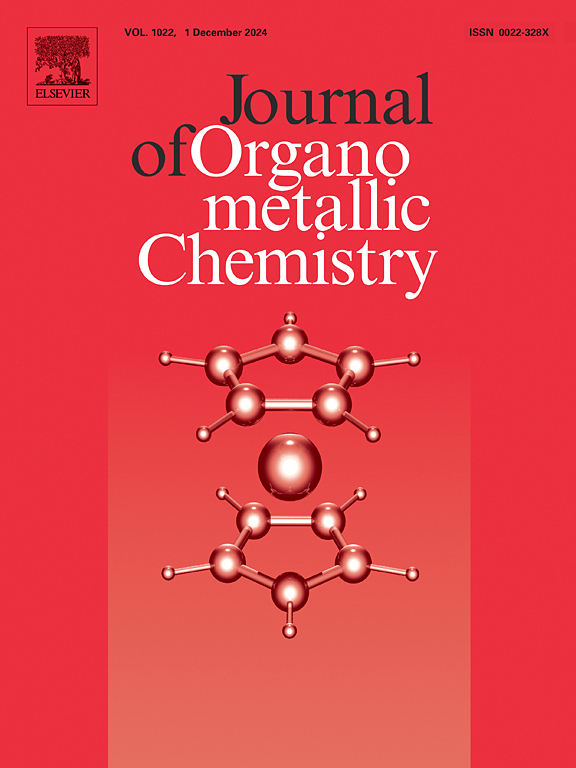Decorated silver nanoparticles over chitosan modified CNTs/Fe3O4 nanoparticles: A recyclable navel catalyst for solvent-free A3 coupling reactions and evaluation of its anti-breast cancer effects
IF 2.1
3区 化学
Q3 CHEMISTRY, INORGANIC & NUCLEAR
引用次数: 0
Abstract
The present research illustrates a sustainable method for the in situ-immobilized Ag nanoparticles on the chitosan biopolymer functionalized Fe3O4 supported over high surface carbon nanotubes (CNT). Numerous amino and hydroxyl organofunctions over chitosan biopolymer facilitated the green synthesis of the Ag NPs from silver ions without toxic reagents. Physicochemical properties of the designed material were further assessed using a number of characterization techniques, including TEM, FE-SEM, EDX, VSM elemental mapping, and ICP analysis. The TEM analysis depicted the Ag NPs deposited on the inner and outer surfaces of the CNT within the size range of 25–30 nm. Map sum spectrum revealed the major component of the nanocomposite as C (76.1 %). VSM studies showed the magnetization saturation value as 18.7 emu/g. The CNTs/Fe3O4@CS/Ag NPs was subsequently employed in the one-pot three component A3 coupling of phenylacetylene, morpholine and diverse aldehydes under solvent-less conditions to afford excellent yields (85–95 %) of a range of propargylamine derivatives. Recyclability was studied for seven consecutive cycles with any discernible reduction in activity. Furthermore, hot filtration and leaching test was carried out to validate the durability of the catalyst. Additionally, cytotoxic properties of the bio-nanomaterial were assessed against human breast cancer cells over MCF-7 cell line. The % toxicity profile against the material load demonstrated a dose dependent increase graph. This outcome is anticipated due to excellent ROS generation ability along with the contribution from chitosan secondary metabolites. The related IC50 value was determined to be 269 μg/mL and was benign to the normal cells. Importance of this research lies beneath the fact, this is the first report of Ag NP doped functionalized magnetic carbon nanotube towards the C![]() H activation type of reaction for the one-pot synthesis of diverse propargylamines and also showed significant anti-breast cancer potential against corresponding cell line, studied in vitro.
H activation type of reaction for the one-pot synthesis of diverse propargylamines and also showed significant anti-breast cancer potential against corresponding cell line, studied in vitro.

壳聚糖修饰的纳米银纳米颗粒修饰CNTs/Fe3O4纳米颗粒:一种可回收的无溶剂A3偶联反应催化剂及其抗乳腺癌作用的评价
本研究提出了一种在高表面碳纳米管(CNT)上负载的壳聚糖生物聚合物功能化Fe3O4上原位固定银纳米粒子的可持续方法。壳聚糖生物聚合物上大量的氨基和羟基有机功能促进了银离子在无毒性试剂的情况下绿色合成银纳米粒子。采用多种表征技术,包括TEM、FE-SEM、EDX、VSM元素映射和ICP分析,进一步评估了所设计材料的物理化学性质。透射电镜分析显示,碳纳米管的内外表面均沉积有银纳米粒子,粒径范围为25 ~ 30 nm。图和光谱显示,纳米复合材料的主要成分为C(76.1%)。VSM研究表明,磁化饱和值为18.7 emu/g。随后,在无溶剂条件下,将CNTs/Fe3O4@CS/Ag NPs用于苯乙炔、啉和多种醛的一锅三组分A3偶联,获得了一系列丙胺衍生物的优异收率(85 - 95%)。可回收性被研究了连续七个循环,任何明显的活动减少。并进行了热过滤和浸出试验,验证了催化剂的耐久性。此外,通过MCF-7细胞系评估了生物纳米材料对人乳腺癌细胞的细胞毒性。对物质负荷的毒性谱显示出剂量依赖的增加图。由于壳聚糖具有良好的ROS生成能力以及壳聚糖次生代谢物的贡献,这一结果是预期的。相关IC50值为269 μg/mL,对正常细胞无害。本研究的重要性在于,这是首次报道Ag NP掺杂功能化磁性碳纳米管用于CH活化型反应,用于一锅合成多种丙胺,并且在体外研究中对相应细胞系显示出显著的抗乳腺癌潜力。
本文章由计算机程序翻译,如有差异,请以英文原文为准。
求助全文
约1分钟内获得全文
求助全文
来源期刊

Journal of Organometallic Chemistry
化学-无机化学与核化学
CiteScore
4.40
自引率
8.70%
发文量
221
审稿时长
36 days
期刊介绍:
The Journal of Organometallic Chemistry targets original papers dealing with theoretical aspects, structural chemistry, synthesis, physical and chemical properties (including reaction mechanisms), and practical applications of organometallic compounds.
Organometallic compounds are defined as compounds that contain metal - carbon bonds. The term metal includes all alkali and alkaline earth metals, all transition metals and the lanthanides and actinides in the Periodic Table. Metalloids including the elements in Group 13 and the heavier members of the Groups 14 - 16 are also included. The term chemistry includes syntheses, characterizations and reaction chemistry of all such compounds. Research reports based on use of organometallic complexes in bioorganometallic chemistry, medicine, material sciences, homogeneous catalysis and energy conversion are also welcome.
The scope of the journal has been enlarged to encompass important research on organometallic complexes in bioorganometallic chemistry and material sciences, and of heavier main group elements in organometallic chemistry. The journal also publishes review articles, short communications and notes.
 求助内容:
求助内容: 应助结果提醒方式:
应助结果提醒方式:


